|
8595 / 9590
The 8590 and 9590 uses the same reference and diagnostics disks
used by the 8595 / 9595 systems. for a list by processor complex, go HERE
SHS15F2247.boo
IBM PS/2 Model 90 XP 486 HMS (Requires IBM Bookreader)
SHS15F2249.boo
IBM PS/2 Model 90 XP 486 HMR (Requires IBM Bookreader)
190-176 IBM Personal System/2 Model 90
XP 486 (8590-0J5, -0J9 AND -0KD)
191-057 IBM Personal System/2 Model 90
XP 486 (8590-0G5 AND 0G9)
191-195 IBM Personal System/2 Model 90
XP 486 (8590-0H5 and 0H9)
192-098 IBM Personal System/2 Model 90
XP 486 (8590-0L9 AND 0LF)
193-082 IBM Personal System/2 Model 90
XP 486 (9590-0LA AND 0LF)
XGA208
Windows
95/98 XGA-2 Display Driver by UZnal
XGA208
WinNT 4 XGA-2 Display Driver by UZnal (limited to 256 colors)
Model 90 Power
Model 90 Front View
Model 90 Planar
Why was Model 90
Introduced?
J1
on 90 Planar
DBA Artifact on 8590s
(Yes, they DO work!)
Model 90 Ports
Mounting Model 90 Vertically
64K Colors Supported under
W98SE
Video Ram
Video
RAM Installation
8590 and
9590 Planar Differences
9590
Floppy Controller
Adapting
34 Pin Clone Cable to 40 Pin Port
Three
Floppy Experience
* Marked 2.88MB Floppy Drives on
8590s
Memory Riser
Orienting
SIMMs on
Riser
Loading
SIMMs
ECA084 Model 90 Memory Riser Card
Error
201
Plastic SIMM Holders
Riser Support Bracket
Memory
Expansion Boards
Planar ADF Sections
(PFF6F.ADF)
Front view
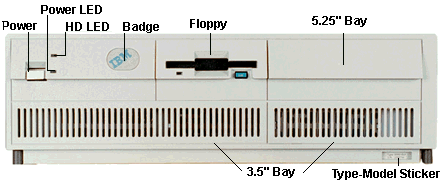
Badge- If grey, XGA. If blue,
XGA-2 Adapter was originally installed (Blue = ISO compliant).
Floppy 1.44MB (8590) or
2.88MB (9590)
5.25" Bay Outer rails are for
a 5.25" drive. The left and center rails are for a 3.5" drive.
8590 / 9590
Planar
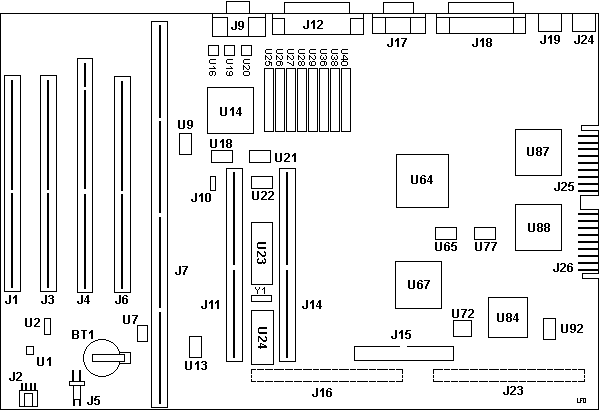
BT1 Battery
J1, 3, 6 Adapter slot
J2 Power switch/speaker
J4 AVE slot
J5 Fan connector
J7 Processor-board
slot
J9 Video
J10 Power-on password
J11, J14 Memory-riser
slot
J12 DB25 Serial Port
J15 40 pin Floppy port
J16, J23 DBA ESDI
port
J17 DB9 Serial Port
J18 Parallel Port
J19 Mouse Port
J24 Keyboard Port
J25, J26
Power-supply
Y1 32.768KHz
U1 LM386 Audio Op Amp
U2 74F30 8-Input NAND
Gate
U7 DS1210 |
U9 41.5390
MHz Used on XGA
U13 14.3181 MHz "System
Oscillator".
U14 37F0842 Used on XGA
U16, 19, 20 TDK ZJY-2P
g Used on XGA
U18 25.175 MHz Used on XGA
U21 44.9000 MHz Used on XGA
U22 28.3220 MHz Used on XGA
U23 Dallas DS1285 RTC
U24 SRM2264LC12
U25-U29 Video Memory
U36, 38, 40 Video Memory
U64 Toshiba TC110GC9AF
(74F5160)
U65 40.0000MHz
DMA Clock
U67 85F0464 (95 M planar)
U72 TI CF61533FN
(64F3110)
U77 22.1184 MHz Clock
U84 N82077AA Floppy
Controller
U87, 88 64F0942 (95 M planar)
- OR -
U87, 88 33F5469 (7568 Resource Card)
U92 24.0000 MHz |
U77 22.1184 MHz Clock for the
"Type 3 High-Speed UART". Divided by 2 for better waveform and 1:1
ratio of low and high.
U64 XGA Display Controller
Early TC110GC9AG / 1888676 Late TC110GC9AF / 74F5160
Audio Over MCA
Why
was the 90 introduced?
Dennis Smith
The Model 90 was intended to be a "desktop server".
It came out in 1989/90. A few years before the Bermuda 77 and
Lacuna
77. The 77 was the replacement for the Mod. 90, but it continued
in
the 95xx Premium Line until about 1994. The main reason for releasing
the
Mod. 90 was most likely to replace the Mod. 70 and to have a desktop
cousin
to the Mod. 95.
NOTE: Recent
developments with
the Type 0 complex demonstrate that the Model 90 CAN boot to a DBA-ESDI
drive as C:, and therefor offers a simple upgrade path for the Model 70
to Model 90, just by swapping the drive out. Type 0 Complex
Martin Adams
One advantage the model 90 has over the 77 is the 8 SIMM
slots. Eight 8M sims are allot cheaper than four 16M sticks right now.
We also
have the caching SCSI that could have its cache upgraded. You don't
have
to pull adapter cards to reconfigure RAM. I prefer the planar mounted
bus
connectors too.
90 Ports

Serial
Port Speed
Dual Direct Memory Address (DMA) serial ports, one
DB25 and one DB9. The DB9 port requires feature number 0217 or 0242 for
attaching devices with 25-pin D shell connectors.
The DMA serial port provides support for speeds from
300 bps to 345.6K bps.The DMA capability reduces processor loading and
overhead when used in higher speed communications. Speeds up to 345.6K
bits per second are supported using IBM Enhanced EIA-232-D which
requires a special shielded cable up to 20 feet long.
Ether serial port can be set to Serial 1-8, with different
arbitration levels for Transmit or Recieve. Both ports are limited to
Int 3.
DMA parallel port
Mounting Model 90 Vertically
IBM supports vertical mounting of the PS/2 Model
9590 when installed in an appropriate fixture approved for such use by
the Underwriter's Laboratory and the Canadian Standards Association.
The IBM PS/2 Model 90 XP 486 must be turned on the left side so that
the left side vents are pointing downward. There must be a minimum of
one inch (25.4mm) between the vents and the supporting fixture.
J1 on 90 Planar

|
Pin
|
Function
|
Pin
|
Function
|
|
1
|
(-) Power LED
|
5
|
(+) SPKR
|
|
2
|
(+) HD LED
|
6
|
(-) SPKR
|
|
3
|
(-) HD LED
|
7
|
(+) PWR
|
|
4
|
(-) PWR
|
8
|
(+) Power LED
|
J16 and J23
Artifact- IBM intended originally to bring out a "low-end"
Mod. 90 with DBA-ESDI and a 386DX-25 / DX-33 processorboard - but
luckily dropped these plans. (Ed. A
big insurance company (Aetna?) had 386DX-20 complexes made for it- the
infamous "Type 0").
Daniel Hamilton has cracked the code and has the DBA-ESDI working. In
short, the DBA-ESDI drive is bootable, but at present, nobody has
dropped a reference partition on one.
64k Colors
under W98SE
To my great surprise, W98SE has 640x480x64k at 60Hz
support. This requires all 8 Video ZIPPs to be installed.
Video Ram
The VRAM chips are Toshiba TC524256BZ-10 or NEC
D42274V-10. The 8590 systems have 8 sockets for
video memory available. The 9590 systems come with 4 VRAM chips (512KB)
soldered to the planar.
NOTE: Even though IBM
Canada site sez the 9590 has XGA-2 integrated into the planar, IT DOES
NOT!!! It has 512K soldered on the planar, plus 4 sockets for the 512K
video memory upgrade. To make the 9590 ISO compliant they had to
install XGA-2 cards
in them.
Video RAM
Installation
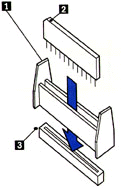
Place the insertion tool (1) over the emptyVRAM socket (If
you have one!)
Align the beveled corner (2) of the VRAM chip towards the
rear of the system. On most 90s, there is a dot on the planar that the
beveled edge (marked with a colored dot sometimes) lines up with.
Carefully align the pins with the socket (3) and firmly
press the module straight down into place
Do not start one end before the other. You can slightly
rock the chip side to side to install into a stiff socket, but be
careful!
Which
Slot
for the XGA-2?
For all complexes with search IML in the complex BIOS (T1
and 2 with upgrade BIOS, all T3 and T4), The XGA-2 may be installed in
Slots
1, 2, and 4. For T1 or T2 with the non-IML search BIOS, Slot 1 must be
filled with an IBM SCSI adapter, and only Slots 2 and 4 may be used for
the XGA-2. Slot 3 is an AVE slot and is physically incompatible. For a
full discussion, go HERE
Differences
between 8590 and 9590 Planars
The 9590 lacks the DBA artifacts, has 512K video memory soldered
on the planar, and is a pretty green. The 9590 planar is identified as
an
XP 90 system board under setup. It does not support Synchrostream. The
parallel port is a standard one, no Expressprint. No Wake on
Ring.
9590
Floppy Controller
82077AA Go to Floppy
page for more. The Model 90 uses the 40 pin floppy header on the
planar.
Adapting
Clone Cable to 40 Pin Port
I picked up some sweet Vantec clone single floppy cables
on ebuy. The space that the normal 90 floppy cable, with it's three
device
cable, is seriously cramped, even without the PSU support strut.This is
a way to remove one 34 pin header, alter the cable, then crimp on a 40
pin
header.
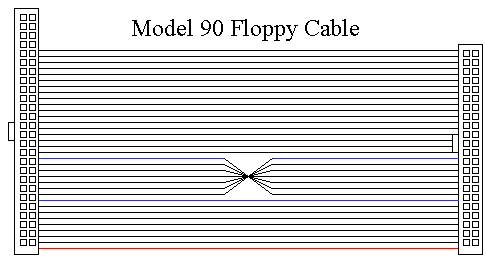
The 40 pin header for the planar is on the left, the 34
pin header for the floppy is on the right. Both have the key positioned
to the left, and both have the holes pointing up, facing you.
From the red wire (pin 1), count up 9 wires and slit about
3" from the 40 pin header. Count up another seven wires, then slit
about 3"
from the 40 pin header. From the upper side, remove 6 conductors, as
they aren't used by floppy A:
Pull wires 10-16 (the ones you slit), and twist them 180
degrees. Align the lower 9 wires, the twisted 7 wires, and the
remaining wires through the 40 pin header. Crimp. Trim excess with
X-Acto knife or similar. Done.
Three
Floppy Experience
Just because people said it isn't done, I threw three 1.44MB
floppies into my 9590. All three showed up under setup as 1.44MB
drives. Under DOS, they are accessable as A:, B:, and D:. Under W95, it
blows the mind of the IOS driver and Win95 says you must shut the
system down and restart Windoze. But under safe mode, I was able to
access and read off the D: floppy.
I will eventually try it under NT 4.0 just for snorts 'n
grins...
* Marked
Floppy Drives on 8590s
Older 8590s may have their floppy controllers FRIED if you
use a 2.88MB floppy that has an asterisk ( * ) on the upper surface of
the eject button. The 9590 is not affected by this charming quirk.
There has to
be an earlier floppy controller other than the 82077AA, which supports
an
asterisk marked floppy on my 9590.
Memory
Riser

Orienting
SIMMs
When inserting SIMMs onto the riser, orient the notch on
the SIMM with the notch on the riser. Always wondered why the riser had
that
seemingly useless extension to the right. Think of the riser as a big
SIMM
with it's notch. Like to like...
Plastic
SIMM Holder Clips
There also was a problem with local power-drops on the early Mod. 90
memory riser cards (the ones with all-plastic SIMM-sockets). Improved
versions
had metal holder clips. And - logically - you should not mix the two
versions.
Memory
Riser Card Support Bracket
There *must* be a plastic Support Bracket clipped over the 2 (two !)
memory riser boards to properly fix them. This part is called "memory
riser card support bracket" and is FRU 57F3029. It also has a "bay" to
guide the SCSI-cable surface wave filter (that large heavy ferro-oxide
block).

Loading
SIMMs Onto Memory Risers
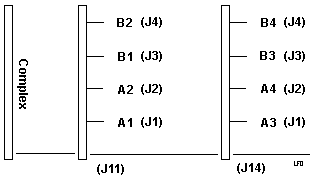
Memory must be loaded in
matched pairs (size and speed) into sockets J1+J3 and J2+J4 for
interleaved configurations. (Type 1, 3, and 4 complexes). Type 2
complexes allow you to stuff SIMMs in
the sockets in any order or combination, but if not in matched pairs
(J1+J3, J2+J4) there will be a performance hit.
Don't stuff one riser with modules (especially
double-sided) and leave the other blank. It *hates* imbalance on the
memory drivers. Try to organize them the way to achieve a balanced load
on *both* memory risers by having equal number of chips per pair, then
on both risers. Certain releases of the Mod. 90 had problems with the
double-sided SIMMs - especially with the 8MB ..
[Ed.] Please genuflect
while absorbing the riser/slot illustration. Remember, for interleaved
configuration, you place matched speed/size SIMMs in A1-B1, A2-B2, and
so on. Please note that the SIMM pairs do NOT cross between memory
risers. The Model 95 uses seperate A and B banks (A1, A2, A3, A4 then
B1, B2, B3, B4) while the Model 90 uses both banks on both cards, A1,
A2, B1, B2 then A3, A4, B3, B4).
ECA084 - Model
90
Memory Riser Card
If memory riser card FRU P/N33F4905 is populated with
"MIXED SIMMs" and is experiencing any of the following errors:
DOS NMI, OS/2 TRAP 0002, POST, or diagnostic memory errors, replace
both memory riser
cards with new FRU P/N81F8823 (two required).
NOTE: "MIXED SIMMs" is
defined as SIMMs with 12 modules or more per SIMM, mixed with SIMMs
having less
than 12 modules per SIMM mounted on the same riser card. If FRU
P/N
81F8823 is already installed, this ECA is not applicable.

Original scan from Al Savage out on the left coast
The "bad" riser (33F4905) has six electrolytic
capacitors on the front. The "good" riser (81F8823) has only the silk
screen outlines for the caps (also a lot more SMD resistors and caps on
the back). Both risers
have metal clips and white SIMM sockets.
Error 201
Error code 201 says "Reseat system board memory" and
can afflict the systemboard as well as the memory only. I would suggest
to remove the memory risers, reseat all modules, plug them back and see
if they are seated properly.
I would also suggest that you start with one single
pair of matching memory modules in the connectors J1 + J3
on riser J11 - the one closer to the processor board. This is just to
test
out if your problem is memory- or systemboard related.
If the machine comes up fine (counts memory) -
install the next pair in sockets J1 + J3 in Riser J14 - the on closer
to the power supply to keep balanced load of the memory decoder lines.
As I wrote: the Mod. 90 has a sensible feeling for imbalanced memory
modules and may "spin out" with somewhat strange and unexplainable
errors by no obvious reason. There once was a recommendation from IBM
on that topic and they explicitely mentioned it for the Mod.90 -
particularly for those cases where double-sided memory modules are used
(which put a higher load on the decoder lines).
Memory
Expansion Boards
You can't. Sort of. The 90 (and 95) does not cache
the memory on expansion boards. So in addition to the overhead in
negotiating for control of the microchannel bus, you have to give up
the advantage of the 486 cache...
AdapterId
FF6F Built In Features (Model 90)
Serial Port
Serial port can be set as Serial 1 through 8 or
disabled. If you are using an ASCII terminal as your system
console, do not disable this port.
<"SERIAL 1
(03f8h-03ffh 083f8h-083ffh, int 4)>, 2 (02f8-02ff
082f8-082ff, int 3), 3 (3220-3227 0b220-0b227, int 3), 4 (3228-322f
0b228-0b22f, int 3), 5 (4220-4227 0c220-0c227 int 3), 6 (4228-422f
0c228-0c22f int 3), 7 (5220-5227 0d220-0d227
int 3), 8 (5228-522f 0d228-0d22f int 3), Disabled
Serial Transmit Arbitration Level
The serial port can use any one of the arbitration levels
for transmitting data. If the level is shared then other devices can be
set at the same level. If the level selected is dedicated then only
this
device can be set to that level.
<"Shared 4"
>, 3, 1, 0, 7, 6, 5, Dedicated 7,
6, 5, 4, 3,
1, 0, Disabled
Serial Receive Arbitration Level
The serial port can be set to any arbitration level for
receiving data. If shared is selected, then other devices can use the
same level.
If the level selected is Dedicated then
only
this device can be set to that level.
<"Shared 3>,
1, 0, 7, 6, 5, 4, Dedicated 7, 6, 5, 4,
3, 1,
0, Disabled
Parallel Port
The parallel port can be set as Parallel 1 through 3 or
disabled.
<"PARALLEL
1" (03bc-03bf 1278-127f int 7)>, 2 (0378-037f int
7), 3 (0278-027f int 7), Disabled NOTE:
Parallel 2 is the one Winblows is comfortable with!
Parallel Port Arbitration Level
The parallel port can be set to any arbitration
levels. If the level selected is shared then other devices can be
set at the same level. If the level selected is dedicated then
only this device can be set to that level. Select
<Disabled> to use the port in compatibility mode.
<"Shared 7">,
6, 5, 4, 3, 1, 0, Dedicated 7, 6, 5, 4,
3, 1,
0, Disabled
Preempt Enable/Disable
System board CPU can preempt continuous data transfers by
other devices for its use of Micro Channel.
<"Enable">,
Disable
Video I/O Address
I/O (Input/Output) address range for the display
controller registers. Also selects the exact location of the
video coprocessor registers.
<"Instance
6: 2160h - 216Fh">, 1 (2110-211F), 2 (2120-212F), 3
(2130-213F), 4 (2140-214F), 5 (2150-215F)
Video ROM Address Space
Memory address range used for the system video ROM.
<"C0000-C1FFF"
>, C2000-C3FFF, C4000-C5FFF, C6000-C7FFF, C8000-C9FFF,
CA000-CBFFF, CC000-CDFFF, CE000-CFFFF, D0000- D1FFF, D2000-D3FFF,
D4000-D5FFF, D6000-D7FFF, D8000-D9FFF, DA000-DBFFF, DC000-DDFFF,
DE000-DFFFF
Video Arbitration Level
The video sub-system can be set to any one of these
arbitration levels.
<"Arbitration
level 13">, 12, 11, 10, 9, 8, 14
Video Fairness
Whether the video sub-system coprocessor will follow the
fairness algorithm for bus usage.
<"Fairness
On">, Off
ADPItem 1 Usable System-Board Memory
(Exec)
This field displays the type of Usable Memory on the
system board. The memory type is either parity or
error-correcting-code (ECC).
9595 Main Page
|





